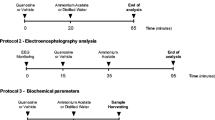Abstract
Hepatic coma was induced in rats chronically treated with CCl4, by means of a single injection of ammonium acetate. The activities of glutamate decarboxylase (GAD) and GABA transaminase (GABA-T), as well as the synaptosomal uptake and release of [3H]GABA, were measured in the following brain areas of the comatose rats: cortex, striatum, hypothalamus, hippocampus, midbrain and cerebellum. Hepatic coma was associated with a general decrease of GAD activity, whereas GABA-T activity was diminished only in the hypothalamus, striatum and midbrain. During hepatic coma, the K+-stimulated [3H]GABA release was notably diminished in the striatum and cerebellum, whereas a significant increase was observed in the hippocampus. [3H]GABA uptake increased in most regions after CCl4 treatment, independently of the presence of coma. The results indicate that GABAergic transmission seems to be decreased in most cerebral regions during hepatic coma.
Similar content being viewed by others
References
Hoyumpa, A. M., and Schenker, S. 1985. Hepatic Encephalopathy. Pages 3083–3120,in Scott, T. V. (ed.), Internal Medicine, Academic Press, New York.
Zeneroli, M. L., Iuliano, E., Racagni, G., and Baraldi, M. 1982. Metabolism and uptake of γ-aminobutyric acid in galactosamine-induced hepatic encephalopathy in rats. J. Neurochem. 38:1219–1222.
Ferenci, P., Covell, D., Schafer, D. F., Waggoner, J. G., Shrager, R., and Jones, E. A. 1983. Metabolism of the inhibitory neurotransmitter γ-aminobutyric acid in a rabbit model of fulminant hepatic failure. Hepatology 3:507–512.
Mans, A. M., Biebuyck, J. F., Davis, D. W., Bryan, R. M., and Hawkins, R. A. 1983. Regional cerebral glucose utilization in rats with portacaval anatomosis. J. Neurochem. 40:986–991.
Schafer, D. F., Fowler, J. M., and Jones, A. 1981. Colonic bacteria: a source of γ-aminobutyric acid in blood. Proc. Soc. Exp. Biol. Med. 167:301–303.
Zaki, A. E. D., Ede, R. J., Davis, M., and Williams, R. L. 1984. Experimental studies of the blood-brain barrier permeability in acute hepatic failure. Hepatology 4:359–363.
Baraldi, M. 1982. Experimental hepatic encephalopathy: changes in the binding of γ-aminobutyric acid. Science 216:427–428.
Schafer, D. F., and Jones, E. A. 1982. Hepatic encephalopathy and the γ-aminobutyric acid neurotransmitter system. Lancet i:18–20.
Roberts, E. 1984. The γ-aminobutyric acid (GABA) system and hepatic encephalopathy. Hepatology 4:342–345.
Schafer, D. F. 1984. Hepatic encephalopathy today. Lancet ii:489–491.
Thompson, J. S., Schafer, D. F., Schafer, G. J., and Hodgson, P. E. 1985. γ-aminobutyric acid plasma levels and brain binding in Eck fistula dogs. J. Surg. Res. 38:143–148.
Tossman, U., Eriksson, S., Delin, A., Hagenfeldt, L., Law, D., and Ungerstedt, U. 1983. Brain amino acids measured by intracerebral dialysis in portacaval shunted rats. J. Neurochem. 41:1046–1051.
Rojkind, M. 1973. Inhibition of liver fibrosis byl-azetidine-2-carboxilic acid in rats treated with carbon tetrachloride. J. Clin. Inves. 52:2451–2456.
Mans, A. M., Saunders, S. J., Kirsch, R. E., and Biebuyck, J. F. 1979. Correlation of plasma and brain amino acid and putative neurotransmitter alterations during acute hepatic coma in the rat. J. Neurochem. 32:285–292.
Giguere, J. F., and Butterworth, R. F. 1984. Amino acids changes in regions of the CNS in relation to function in experimental portal-systemic encephalopathy. Neurochem. Res. 9:1309–1321.
Heffner, T. G., Hartman, J. A., and Sieden, L. S. 1980. A rapid method for the regional dissection of the rat brain. Pharmac. Biochem. Behav. 13:453–456.
Löscher, W., Bohane, G., Muller, F., and Pagliusi, S. 1985. Improved method for isolating synaptosomes from 11 regions of one rat brain: Electron microscopic and biochemical characterization and use in the study of drug effects on nerve terminal γ-aminobutyric acid in vivo. J. Neurochem. 45:879–889.
Tapia, R., and Sitges, M. 1982. Effect of 4-aminopyridine on transmitter release in synaptosomes. Brain Res. 250:291–299.
Fricke, U. 1975. Tritosol: a new scintillation cocktail based on Triton-X-100. Anal. Biochem. 63:555–558.
Albers, R. W., and Brady, R. D. 1959. The distribution of glutamic acid decarboxylase in the nervous system of the Rhesus monkey. J. Biol. Chem. 234:926–928.
Jakoby, S. J. 1959. Soluble γ-aminobutyric-glutamic transaminase from Pseudomonas fluorescens. J. Biol. Chem. 234:932–937.
Kun, E. J., and Kearney, E. B. 1974. Ammonia. Pages 1802–1806,in Bergmeyer, H. V., (ed.), Methods of Enzymatic Analysis, Academic Press, New York.
Reitman, S., and Frankel, S. 1957. Determination of serum transaminase. Am. J. Clin. Path. 28:56–64.
Malloy, H. T. 1937. The separation of serum pigments giving the direct and indirect Van den Bergh reaction. Biol. Chem. 119:481–489.
Lowry, O. H., Rosebrough, N. J., Farr, A. L., and Randall, R. J. 1951. Protein measurement with the Folin phenol reagent. J. Biol. Chem. 193:265–275.
Rojkind, M., and Kershenobich, D. 1975. Effect of colchicine on collagen, albumin and transferrin synthesis by cirrhotic rat liver slices. Biochim. Biophys. Acta 378:415–423.
Ferenci, P., Schafer, D. F., Kleinberger, G., Hoofnagle, J. H., and Jones, E. A. 1983. Serum levels of gamma-aminobutyric acid-like activity in acute and chronic hepatocellular disease. Lancet ii:811–814.
Hindfelt, B., Plum, F., and Duffy, T. E. 1977. Effect of acute ammonia intoxication on cerebral metabolism in rats with portacaval shunts. J. Clin. Inves. 59:386–396.
Tapia, R. 1983. γ-aminobutyric acid. Metabolism and biochemistry of synaptic transmission. pages 423–466,in Lajtha, A. (ed.). Handbook of Neurochemistry, vol. 3, Plenum Press, New York and London.
Ferenci, P., Jacobs, R., Pappas, S. C., Schafer, D. F., and Jones, E. A. 1984. Enzymes of cerebral GABA metabolism and synaptosomal GABA uptake in acute liver failure in the rabbit: Evidence for decreased cerebral GABA-transaminase activity. J. Neurochem. 42:1487–1490.
Author information
Authors and Affiliations
Rights and permissions
About this article
Cite this article
Díaz-Muñoz, M., Tapia, R. Regional brain GABA metabolism and release during hepatic coma produced in rats chronically treated with carbon tetrachloride. Neurochem Res 13, 37–44 (1988). https://doi.org/10.1007/BF00971852
Accepted:
Issue Date:
DOI: https://doi.org/10.1007/BF00971852




